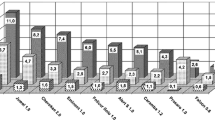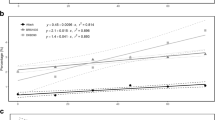Abstract
Fusarium head blight (FHB) of wheat heads by Fusarium culmorum causes serious yield losses and compromises the end-use quality by accumulation of mycotoxins and alteration of baking characteristics. The most promising control strategies against the disease combine adequate cropping techniques (i.e. crop rotation avoiding maize as a preceding crop) with the use of resistant varieties. Different types of resistance against this disease have been described such as the resistance to primary infection of the spikelets and the reduction of spread of the infection in other parts of the ear. In recent years, the ability of the kernels to prevent penetration of the fungus and mycotoxin accumulation has received increasing attention. Yet, the detection of kernel resistance for breeding purposes is rather difficult, as the corresponding resistance mechanisms are not fully understood. The aim of the present work is to compare different aspects of kernel resistance in order to define the most significant criteria for breeding purposes. The experimental set up included eight modern Swiss spring wheat varieties grown on small irrigated yield plots (3 × 1.5 m) inoculated at anthesis with a mixture of Fusarium culmorum isolates. Disease ratings from 7 to 28 days post-inoculation were completed with post-harvest analyses for the accumulation of the mycotoxin deoxynivalenol and different baking quality parameters. Results indicate that the accumulation of the mycotoxin deoxynivalenol in the kernels is correlated with visible symptoms on the ear before harvest. In terms of baking quality parameters, water absorption, dough softening and dough resistance are impaired in susceptible varieties after FHB infection, while resistant varieties are not affected. The results obtained here indicate that kernel resistance can be defined by low deoxynivalenol accumulation in the kernels and by stability of several baking quality parameters under conditions of high FHB infection pressure.




Similar content being viewed by others
Abbreviations
- AUDPC:
-
area under the disease progress curve
- DON:
-
deoxynivalenol
- FHB:
-
Fusarium head blight
References
AACC (2002). Approved methods of the American Association of Cereal Chemists, 10–05 Guidelines for Measurement of Volume by Rapeseed Displacement. American Association of Cereal Chemists.
Berova, S., & Mladenov, M. (1974). Influence of wheat ear and grain fusariosis Fusarium graminearum (Schwabe) on the chemical, technological and baking qualities. Plant Science (Bulgaria), 11, 125–133.
Bockmann, H. (1964). Qualität und Backfähigkeit von Weizen bei Befall mit Septoria nodorum Berk. und Fusarium culmorum Link. Nachrichtenblatt des Deutschen Pflanzenschutzdienstes, 16, 5–10.
Bottalico, A., & Perrone, G. (2002). Toxigenic Fusarium species and mycotoxins associated with head blight in small-grain cereals in Europe. European Journal of Plant Pathology, 108, 611–624.
Boyacioğlu, D., & Hettiarachchy, N. S. (1995). Changes in some biochemical components of wheat grain that was infected with Fusarium graminearum. Journal of Cereal Science, 21, 57–62.
Brabant, C., Fossati, D., & Kleijer, G. (2006). La sélection du blé de printemps en Suisse. Revue Suisse d’Agriculture, 38, 73–80.
Cahanier, B. (2001). Céréales et mycotoxines. Généralités, présences, dosage. Industries des céréales, 122, 22–29.
Cambell, C. L., & Madden, L. V. (1990). Introduction to plant disease epidemiology. New York: Wiley.
Collaud, J.-F., Schwärzel, R., Bertossa, M., Menzi, M., Anders, M., Peter D., et al. (2005). Variétés de céréales recommandées par l’interprofession pour la récolte 2006. Revue Suisse d'Agriculture, 37, insert.
Dexter, J. E., Clear, R. M., & Preston, K. R. (1996). Fusarium head blight: Effect on the milling and baking of some Canadian wheats. Cereal Chemistry, 73, 695–701.
Hareland, G. A. (2003). Effects of pearling on falling number and alpha-amylase activity of preharvest sprouted spring wheat. Cereal Chemistry, 80, 232–237.
Jones, R. K., & Mirocha, C. J. (1999). Quality parameters in small grains from Minnesota affected by Fusarium head blight. Plant Disease, 83, 506–511.
Kang, Z., & Buchenauer, H. (1999). Immunocytochemical localisation of Fusarium toxins in infected wheat spikes by Fusarium culmorum. Physiological and Molecular Plant Pathology, 55, 275–288.
Logrieco, A., Bottalico, A., Mule, G., Moretti, A., & Perrone, G. (2003). Epidemiology of toxigenic fungi and their associated mycotoxins for some Mediterranean crops. European Journal of Plant Pathology, 109, 645–667.
Mascher, F., Michel, V., & Browne R. A. (2005). Breeding of resistant wheat and triticale varieties against Fusarium head blight. Revue Suisse d’Agriculture, 37, 189–194.
McMullen, M., Jones, R., & Gallenberg, D. (1997). Scab of wheat and barley: A re-emerging disease of devastating impact. Plant Disease, 81, 1340–1348.
Mesterhazy, A. (1995). Types and components of resistance to Fusarium head blight of wheat. Plant Breeding, 114, 377–386.
Meyer, D., Weipert, D., & Mielke H. (1986). Beeinflussung der Qualität von Weizen durch den Befall mit Fusarium culmorum. Getreide, Mehl und Brot, 40, 35–39.
Moore, W. R. (1994). Significance of Fusarium infected wheat and vomitoxin in wheat based foods. Cereal Foods World, 39, 625.
Pelshenke, P. F., Schulz, A., & Stephan, H. (1970). Der Rapid Mix Test als Standard-Backmethode für Weizen. Merblatt no.62 der Arbeitsgemeinschaft Getreideforschung e.V., Detmold p. 1–6.
Protic, N., & Protic, R. (2000). The influence of some Fusarium mycotoxins on the quality of bread. In: Proceedings of the 11th ICC Cereal + Bread Congress and of the 50th Australian Cereal Chemistry Conference 11–14. August 2000. Surfers Paradise, Queensland, Australia.
Rabenstein, F., Wesemann, M., Lind, V., & Miedaner, T. (2000). Serologischer Nachweis von Fusarium spec. in Getreidekörnern. Phytomedizin, 30, 19.
Saur, L., & Benacef, N. (1993). Relation entre les symptômes de fusariose de l’épi et la perte de rendement chez le blé tendre. Agronomie, 13, 829–833.
Schroeder, H. W., & Christensen, J. J. (1963). Factors affecting resistance of wheat to scab caused by Gibberella zeae. Phytopathology, 53, 831–838.
Scott, P. M., Kanhere, S. R., Lau, P.-Y., Dexter, J. E., & Greenhalgh, R. (1983). Effects of experimental flour milling and breadbaking on retention of deoxynivalenol (vomitoxin) in hard red spring wheat. Cereal Chemistry, 60, 421–424.
Seitz, L. M., Yamazaki, W. T., Clements, R. L., Mohr, H. E., & Andrews, L. (1985). Distribution of deoxynivalenol in soft wheat mill streams. Cereal Chemistry, 62, 467–469.
Snijders, C. H. A., & Krechting, C. F. (1992). Inhibition of deoxynivalenol translocation and fungal colonization in Fusarium head blight resistant wheat. Canadian Journal of Botany, 70, 1570–1576.
Snijders, C. H. A., & Perkowski, J. (1990). Effects of head blight caused by Fusarium culmorum on toxin content and weight of wheat kernels. Phytopathology, 80, 566–570.
Wang, Y. Z., & Miller, J. D. (1988). Effect of Fusarium graminearum metabolites on wheat tissue in relation to Fusarium head blight resistance. Journal of Phytopathology, 122, 118–125.
Acknowledgements
The authors with to thank Stefan Kellenberger and Philippe Esselborn for technical assistance and Matthias Lutz from ETH Zürich and Francis Hesford for critically reading the manuscript. This work was supported by Agroscope Changins-Wädenswil research station ACW and Fonds DSP which are gratefully acknowledged.
Author information
Authors and Affiliations
Corresponding author
Rights and permissions
About this article
Cite this article
Gärtner, B.H., Munich, M., Kleijer, G. et al. Characterisation of kernel resistance against Fusarium infection in spring wheat by baking quality and mycotoxin assessments. Eur J Plant Pathol 120, 61–68 (2008). https://doi.org/10.1007/s10658-007-9198-5
Received:
Accepted:
Published:
Issue Date:
DOI: https://doi.org/10.1007/s10658-007-9198-5




